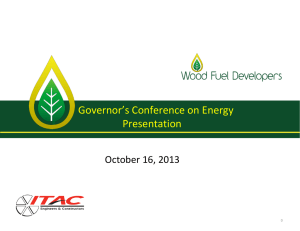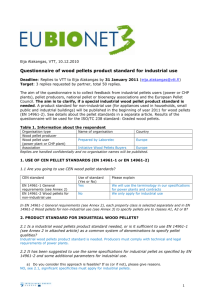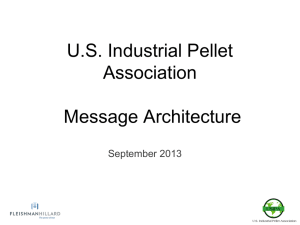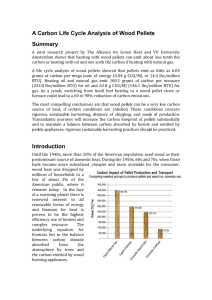Anupama Krishnan - Impacts of PSD on Wood Pellet Manufacturing
advertisement
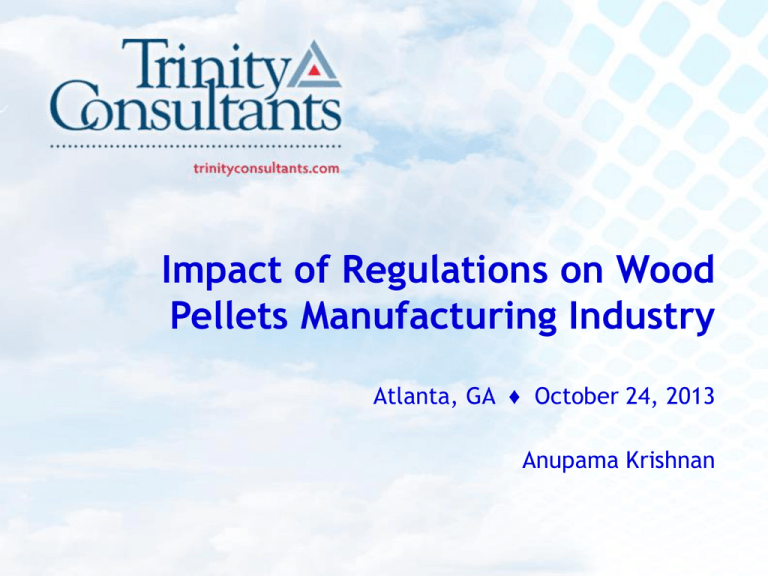
Impact of Regulations on Wood Pellets Manufacturing Industry Atlanta, GA ♦ October 24, 2013 Anupama Krishnan Outline ˃ Why Wood Pellets? ˃ How are Wood Pellets Made? ˃ Impact of International Regulations on ˃ ˃ ˃ ˃ Growth of Industry in the U.S. Regulatory Applicability Results of Testing and Impact on PSD Applicability Case Studies Impact of Biomass Deferral Rule Vacatur for Industry What is a Wood Pellet? > Raw wood compacted into a homogeneous product Processed residues (i.e., chips, bark, sawdust by-products) Unprocessed residues (i.e., tree tops, branches, non- saleable wood, forest thinning) Uniform-size cylindrical shapes > Variety of fuel applications > Residential heating appliances Large scale boilers in commercial operations Raw Wood vs. Wood Pellets Parameter Raw Wood Wood Pellets Energy Density Low High (similar to coal) Moisture Content 50% <10% Bulk Density Low High Why Wood Pellets? ˃ Every ton of pellets used vs. oil reduces CO2 emissions by about 1.5 tons ˃ Wood pellets have a fossil energy ratio (net energy output/fossil energy used) of 12:1 ˃ Good for the environment Improves air quality Better waste management Sustainable sources How are Pellets Manufactured? Pelletizing Drying Material Processing Cooling Storage Wood Pellet Carbon Cycle Source: Enviva (2/12) International Interest in Wood Pellets ˃ Europe has incentives for using renewable fuels Rising fossil fuel prices Tax on fossil fuels Green electricity certification system Big push to reduce CO2 emissions Large-scale boiler applications and residential furnaces with secure supply of wood pellets International Interest in Wood Pellets ˃ Islands are looking into sustainable sources ˃ Low conversion costs for utilities Coal to wood pellets ˃ Predictable and reliable ˃ Sustainable raw materials Why Manufacture in the USA? > Largest privately owned and sustainably managed forest resource in the world > Can easily export wood pellets both east to Europe and west to Asia > The primary product grown by Southeast U.S. timberland owners is softwood saw timber Southern yellow pine Southern Yellow Pine > Commonly found in Southeast U.S. Grows well in acidic soils More than 32 million acres of pine are grown in the southeastern U.S. (Forest Nutrition Cooperative) > Has a lower density Easier to chip and mill into pellets than hardwood > Grows relatively fast ~20 years Wood Pellet Mills – North America Source: Klean Industries Wood Pellet Trade Flow Source: USIPA Conference (10/12) Future Wood Pellet Production Source: Global Wood Pellet Industry Market and Trade Study (12/11) Federal Regulations Applicable to the Wood Pellets Industry ˃ CAM – potentially applicable for control devices ˃ NSPS Subpart Db (Steam Generating Units) or NSPS Subpart Dc (Small Steam Generating Units) potentially applicable if heat source uses steam to heat dryer or if it creates steam for other process operations ˃ NESHAP Subpart DDDD (PCWP MACT) – not applicable since adhesives not used for pellet formation Boiler MACT or Boiler GACT – potentially applicable to heat source used to generate steam ˃ Engine NSPS/NESHAP for generators or emergency fire pumps Sound solutions delivered uncommonly well Impact of Post-Dryer VOCs on PSD Applicability ˃ Initial facility designs did not account for any post-dryer VOC emissions ˃ Later testing conducted at several facilities indicated very high amounts of VOC emissions from the post-drying process – hammermills, pelletizing and storage ˃ Facilities may require PSD permitting with BACT, or consider expensive VOC controls for PSD avoidance Sound solutions delivered uncommonly well Possible Compliance Testing Requirements ˃ Heat Energy Source/Dryer Stack VOC CO NOX PM/Opacity Formaldehyde Methanol Acetaldehyde ˃ Post-Dryer Sources Stacks VOC ˃ Initial testing requirements likely; annual or biannual testing requirements dependent on testing results Sound solutions delivered uncommonly well Use of Testing Data ˃ GA EPD recommended wood pellets industry VOC emission factors based on engineering testing results for Georgia Biomass facility ˃ Testing results can vary greatly depending on process, type of wood, control methods, etc. ˃ If test data is unavailable for a site, EPD will accept test data from another site with a similar process; however, testing will be required to confirm emissions values If actual test results are much higher than PTE in application (e.g., above PSD major source thresholds), the site faces potential compliance actions Sound solutions delivered uncommonly well Impact of Biomass Deferral Rule Vacatur ˃ Vacatur of rule may have significant impacts on the future of this industry in the U.S. ˃ GHG emissions from wood pellets and other biogenic sources can no longer be excluded in PSD applicability determinations ˃ Facilities may easily trigger PSD for GHGs, thereby be subject to cumbersome PSD permitting or avoidance, BACT evaluations and modeling assessments ˃ If U.S. becomes a less profitable market for wood pellets, Europe may well turn to emerging markets like Brazil to fulfill demand Sound solutions delivered uncommonly well Pellet Facility #1 – Regulations Impact ˃ Greenfield site ˃ Originally permitted as Title V major, PSD minor source ˃ Internal testing revealed significant VOC emissions from post-dryer sources not previously accounted for ˃ Received Consent Order from EPD and installed RCOs on post-dryer sources to remain PSD minor source ˃ Incurred significant financial penalties Sound solutions delivered uncommonly well Pellet Facility #2 – Regulations Impact ˃ Conversion of existing wood product facility into wood pellet production ˃ Originally permitted as Title V synthetic minor ˃ EPD permitted as Title V major source, to be confirmed with testing ˃ Operation limitations accepted to avoid PSD permitting No VOC emissions controls for dryer or postdryer operations Sound solutions delivered uncommonly well Pellet Facility #3 – Regulations Impact ˃ Future conversion of an existing wood pellet facility ˃ Previously permitted as synthetic minor with respect to Title V ˃ Revise permitting based on new testing data from sister facility site for post-dryer VOC emissions for PSD avoidance ˃ Revise permitting for vacatur of biomass deferral Natural gas usage instead of biomass for combustion for PSD avoidance Sound solutions delivered uncommonly well Thank You! Questions? Anupama Krishnan akrishnan@trinityconsultants.com Ph No.: (678)-441-9977 Sound solutions delivered uncommonly well

